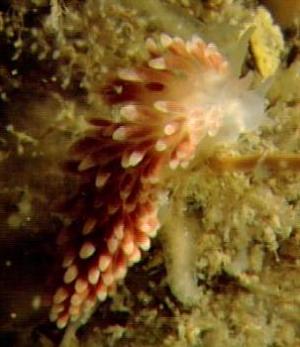
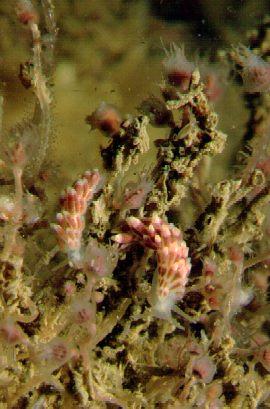
Cuthona gymnota
(Couthouy, 1838)
Order: NUDIBRANCHIA
Suborder: AEOLIDINA
Family: Tergipedidae
DISTRIBUTION
North Atlantic from Mediterranean to Norway, and Canadian Arctic to New Jersey, USA.
PHOTO
The Netherlands. Photos: Peter van Bragt.
Feeds mainly on hydroids of the genus Tubularia and passes through a number of generations each year. Bleakney (1996) reports that it changes from one seasonal species of Tubularia to another in Atlantic Canada as the year progresses. Grows to about 20mm in length but usually smaller.
References:
• Bleakney, S. (1996) Sea Slugs of Atlantic Canada and the Gulf of Maine.
• Thompson, T.E. & Brown, G.H. (1984) Biology of Opisthobranch Molluscs, Vol 2. Ray Society: London.
Rudman, W.B., 2000 (September 17) Cuthona gymnota (Couthouy, 1838). [In] Sea Slug Forum. Australian Museum, Sydney. Available from http://www.seaslugforum.net/find/cuthgymn
Related messages
Re: Cuthona gymnota? from Cork, Ireland
June 20, 2006
From: Marina Ossokine
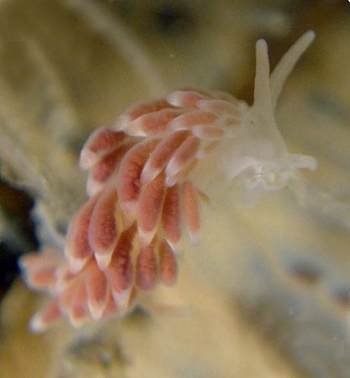
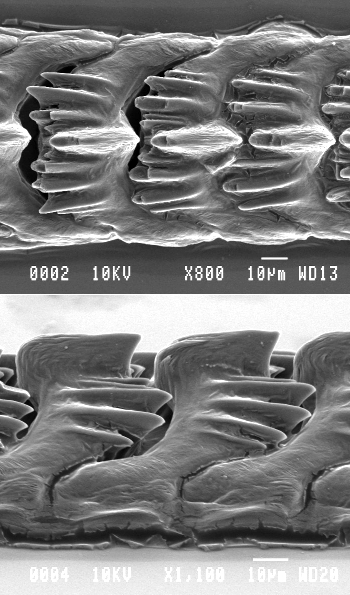
Concerning message #16843:
Dear Bill and Jamie,
In my humble opinion, these animals aren't Cuthona gymnota (please let me call it so). In Arcachon Basin C. gymnota is a very common species in early spring when there is plenty of Tubularia everywhere. Jamie's animals don't look like my specimens for the following reasons :
- Jamie's animals are twice the largest size of C. gymnota
- the usual colour of C. gymnota is pale red / brown. I have never seen animals with so bright red colour by far
- the egg-mass of C. gymnota is very different from the one in Jamie's photo.
Please, see attached here the photos of an adult C. gymnota with the characteristic egg-mass. As you can see it, the curved packets of eggs are inside one single envelope. Also, I'm adding here a SEM photo of the radula showing the distinctive recessed median cusp characteristic of this species.
Locality: 'Hortense', Cap Ferret, Arcachon Basin, 4-5m , France, Atlantic Ocean, February 2005 & 2006 , fields of Tubularia. Length: animal : 12mm / eggs : 5mm + 3mm . Photographer: Marina Poddubetskaia Ossokine.
As for Jamie's animals, from the general shape and the related egg-mass, I think it is a Flabellina, but I couldn't suggest you the species. In Arcachon, another red Flabellina feeds on Tubularia - F. lineata, but it doesn't fit that species either.
Best wishes,
Marina.
Nembro website
nembro@nembro.info
Poddubetskaia Ossokine, M., 2006 (Jun 20) Re: Cuthona gymnota? from Cork, Ireland. [Message in] Sea Slug Forum. Australian Museum, Sydney. Available from http://www.seaslugforum.net/find/16892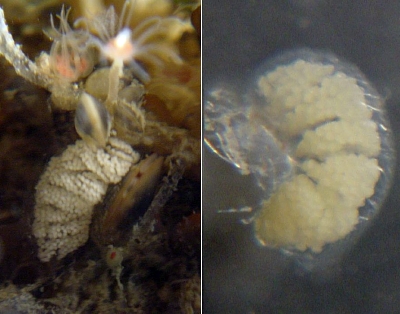
Dear Marina,
I agree that it looks like a Flabellina, that's why my Cuthona gymnota identification was tentative. Thanks for the photos of the radula and egg mass. It's funny how I misinterpreted Bernard's description of the egg mass. I envisaged his curved packets of eggs being arranged end to end like a string of sausages.
Interestingly this egg 'package' looks very similar to that in an earlier photo from XiKun Song [message #14556] of the egg mass of Pseudobornella orientalis which also lives on Tubularia. If Song had not mentioned he had seen Pseudobornella laying these eggs, I would have wondered whether there was a similar species of Cuthona in the Taiwan Straits.
Best wishes,
Bill Rudman
Cuthona gymnota? from Cork, Ireland
June 16, 2006
From: Jamie Malone
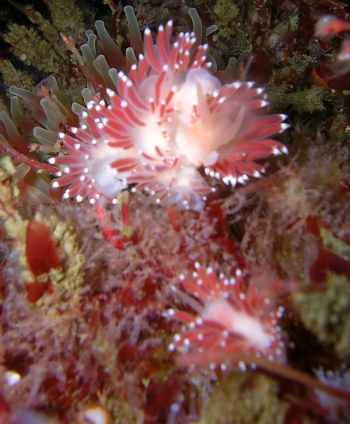
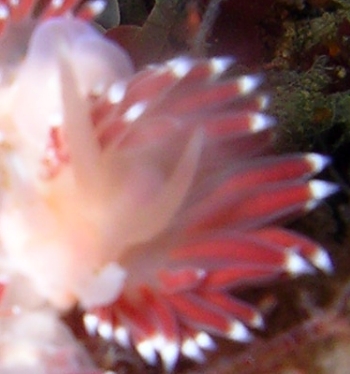
Dear Bill,
Here is another one from Fastnet.
Locality: Fastnet light house, 6 metres, Fastnet, West Cork, 04 June 2006, rocky shore line . Length: 40 mm. Photographer: Jamie Malone.
Jamie Malone
malonejamie@hotmail.com
Malone, J., 2006 (Jun 16) Cuthona gymnota? from Cork, Ireland. [Message in] Sea Slug Forum. Australian Museum, Sydney. Available from http://www.seaslugforum.net/find/16843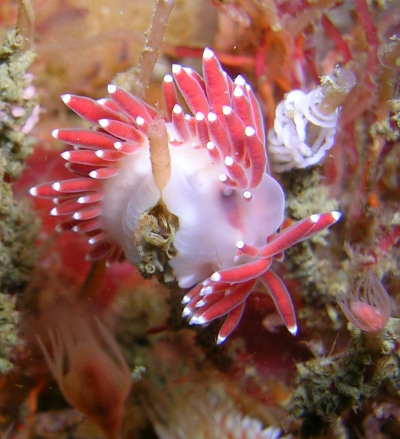
Dear Jamie,
There are a number of aeolids found in your waters which look like these animals. Unfortunately the way they are curled around the hydroid stalk - and each other - hide most of the characters we could use to identify them easily. So my identification of these as Cuthona gymnota is a little tentative.
Cuthona gymnota feeds on Tubularia, which is what your animals are on, and it does not have any white pigmentation on the body or head tentacles, which as far as I can is the case in your animals. What would be positive proof is if the anterior corners of the foot were rounded, but I can't see them. Another point in favour of Cuthona gymnota is the shape of the egg ribbon, which Picton & Morrow (1994) say "consists of curved lozenge shaped packets of eggs", which fits the egg mass in your photo.
There are three species of Flabellina which are also very similarly coloured: Two of them, Flabellina gracilis and F. pellucida usually eat hydroids of the genus Eudendrium, which suggest your animals are not those species. F. verrucosa feeds on Tubularia, but it has a white median line on the body. The other species of Flabellina have white markings on the head tentatcles (rhinophores, oral tentacles) and the body, none of which are visible in your photos.
Hopefully, a local expert can confirm or correct my identification
Best wishes,
Bill Rudman
Cuthona gymnota from Maine, USA
September 2, 2003
From: Alan Shepard
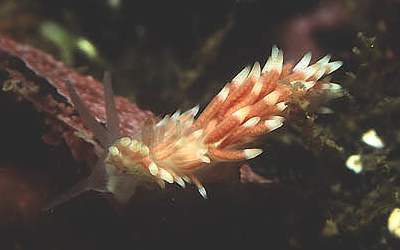
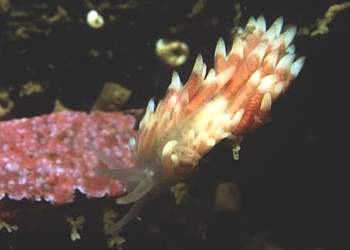
Bill -
Here is another nudibranch from Eastport, Maine. This is Cuthona gymnota, confirmed by Dr. Larry Harris of the University of New Hampshire.
I found it in approximately 10m of water. It was approximately 15mm long. C. gymnota feeds upon tubularian hydroids and in particular the stolons of the hydroids. Bleakney makes interesting commentary concerning concerning the cnidosacs and the fact that C. gymnota feeds on the stolons which lack mature mature nematocysts.
Best wishes,
Alan Shepard
Tolland, CT, USA
alan.chepard@snet.net
Shepard, A., 2003 (Sep 2) Cuthona gymnota from Maine, USA. [Message in] Sea Slug Forum. Australian Museum, Sydney. Available from http://www.seaslugforum.net/find/10863Dear Alan,
In an earlier message I discuss how the distinctive radula of this species, and a few others, seems to be correlated with the habit of eating through the wall of the hydroid's stolon rather than biting off the polyp. Bernard Picton mentions that species of Doto eat in a similar fashion. Interestingly their central radular teeth, are of similar shape
Best wishes,
Bill Rudman
Re: Photos of Cuthona gymnota
March 23, 2001
From: Bernard Picton
Dear Bill,
It's interesting that you think the radula with the central cusp set back is characteristic of species feeding on the stems/stolons of hydroids. This is exactly what Catriona gymnota does, it feeds on Tubularia which has big polyps, but is always on the stems or at the base of the hydroid so I guess it is eating through the stem to feed. I've never seen it in a position to eat the polyps. Doto species seem to drill holes in the hydroid stems and feed in this way too. I think they do this partly to avoid the very venomous Plumulariid nematocysts of their normal foods.
Bernard
bernard.picton.um@nics.gov.uk
Picton, B., 2001 (Mar 23) Re: Photos of Cuthona gymnota. [Message in] Sea Slug Forum. Australian Museum, Sydney. Available from http://www.seaslugforum.net/find/4021Photos of Cuthona gymnota
March 20, 2001
From: Bernard Picton
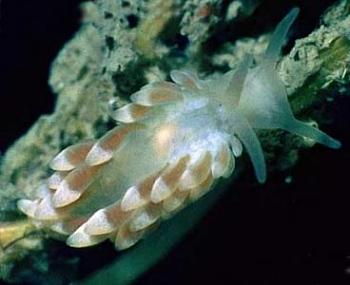
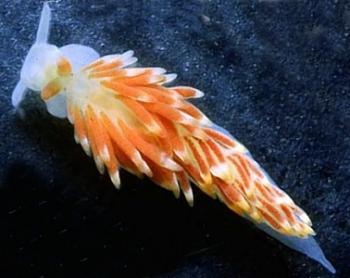
Hi Bill,
Concerning my message about Cuthona sp. 5. Here are two pictures of Cuthona gymnota.
In C. gymnota the rhinophores and oral tentacles don't have white surface pigment and are colourless or tinged with orange. The rhinophore and oral tentacle pigmenation in these species is usually a reliable character in my experience. I still use Catriona for this species as it seems different to the other British species of Cuthona in a number of ways and has a distinctive radula.
UPPER: Skomer Is., S. Wales. - June 1976
LOWER: Streymoy, Faeroe Is. - July 1980 - more brightly pigmented than normal for the British Isles.
Bernard
bernard.picton.um@nics.gov.uk
Picton, B., 2001 (Mar 20) Photos of Cuthona gymnota. [Message in] Sea Slug Forum. Australian Museum, Sydney. Available from http://www.seaslugforum.net/find/3998Thanks Bernard,
These small aeolids seem to cause problems with identification worldwide. I suspect part of the problem is the subleties and complexities of their colour patterns, which are difficult to describe in words. Hopefully the more colour photos we can publish, the greater the chance of clarifiying the differences.
Concerning Catriona, I agree that we probably have not heard the final word on the genera in this group. Unfortunately we had got to the point where every slight difference was being elevated to generic status which didn't help either. In my experience, the C. gymnota - type radula, in which the central cusp is set back from the other cusps, seems to occur amongst species which seem to be feeding on the hydroid tisue in the 'roots' or stolons of the hydroid colony rather than the polyps. I haven't any rigorous experimental evidence to support that, but some cuthonids seem to be found nestling in the basal parts of the colonies rather than up near the polyps. Have you noticed any such difference?
best wishes,
Bill Rudman
Cuthona gymnota from the Netherlands
September 26, 2000
From: Peter H. van Bragt


Dear Bill
Enclosed you will find some images of Cuthona gymnota that have been found in the Netherlands.
Best regards
Peter H. van Bragt
vanbragt.phjm@hsbrabant.nl
van Bragt, P.H., 2000 (Sep 26) Cuthona gymnota from the Netherlands. [Message in] Sea Slug Forum. Australian Museum, Sydney. Available from http://www.seaslugforum.net/find/3004Thanks Peter,
Bill Rudman.
